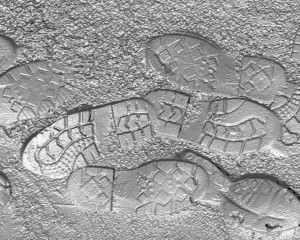 Take a look at the soles of your favourite shoes – those trainers that you always wear. Assuming that they are not brand new you will see that the tread is worn. May be you walked over something sharp and can see a small cut or knick in the tread? Or are the heels slightly worn down on one side like mine? You may have a shoe that is worn by millions but the sole will be distinctive to you and will contain a history of wear that has the potential to say something very specific about you.
Take a look at the soles of your favourite shoes – those trainers that you always wear. Assuming that they are not brand new you will see that the tread is worn. May be you walked over something sharp and can see a small cut or knick in the tread? Or are the heels slightly worn down on one side like mine? You may have a shoe that is worn by millions but the sole will be distinctive to you and will contain a history of wear that has the potential to say something very specific about you.
The potential forensic applications of this are considerable. Most footwear traces at crime scenes are two-dimensional formed when blood or bodily fluids are tracked over a floor but some are three-dimensional where the shoe has left an impression on a muddy verge, path or even in a flower bed. These traces are traditionally recorded by crime scene officers by casting them in plaster or simply through photography. Using techniques developed in the study of ancient footprints staff from the Institute for Studies in Landscape and Human Evolution are trying to change this. They are currently translating their work on ancient footprints into practical tools for use by crime scene officers both within the UK and overseas. The aim is to develop an integrated software system that deals with the whole process from capture through analysis to court room reporting. To help develop this software system the developers need data and this is where you can help. Why not come down to the beach this weekend and leave your footprints for science? The data will be used to help trial the new software and develop automated algorithms – computer code – for the registration of multiple tracks. Machine learning is where a computer learns by trial and error but to learn a computer needs data and that is where you can help.
So if you are interested in forensic science or are an avid fan of CSI on TV then come down and see how you can get involved in developing a new forensic tool.